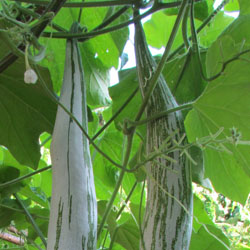
Widely cultivated as a food plant across the world, this plant certainly has a place in Duane’s World Garden. Bitter is a taste for which humans have a particular DNA gene. Yep! You’ve got it or you don’t. This plant can tell you without a DNA test whether you have it. I love bitter melon.



The attractive deeply lobed leaves are reported through world cultures to be used as a medicinal tea for diabetes. The orange ripeness signals to me that there are sweetish red seed coverings inside to be snacked upon. The green fruit of this plant is what is generally thought of as the crop. It is salted to remove the bitterness (for me it is not necessary). The green fruit can be pickled, fried, steamed probably other ways of cooking as well. For me, when I am in the garden, I take it and nibble across the bumpy skin like it is an ear of corn — uncooked. Yep, even the cultures that have grown up with this vegetable think I’ve gone bitter melon crazy. I’ve got the bitter gene!



References:
- Wikipedia: https://en.wikipedia.org/wiki/Momordica_charantia
- The Genetics of Bitter Taste: https://learn.genetics.utah.edu/content/basics/ptc/


